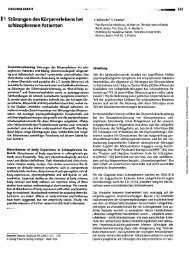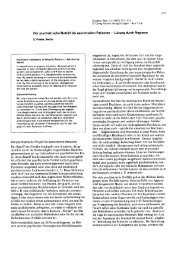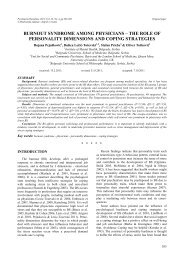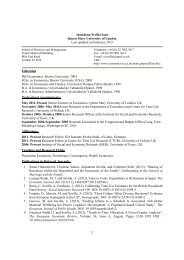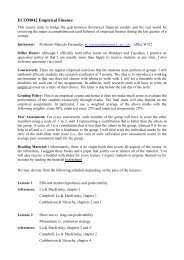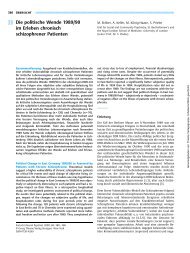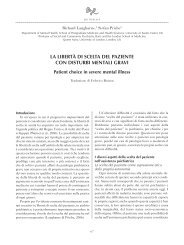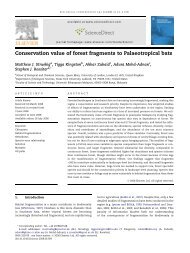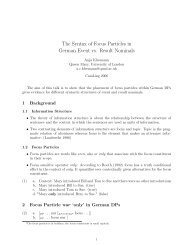Speech Patterns of Japanese Girls or Gals - Personal Webspace for ...
Speech Patterns of Japanese Girls or Gals - Personal Webspace for ...
Speech Patterns of Japanese Girls or Gals - Personal Webspace for ...
You also want an ePaper? Increase the reach of your titles
YUMPU automatically turns print PDFs into web optimized ePapers that Google loves.
<strong>Speech</strong> <strong>Patterns</strong> <strong>of</strong> <strong>Japanese</strong> <strong>Girls</strong> <strong>or</strong> <strong>Gals</strong>:<br />
Symbol <strong>of</strong> Identity & Opposition to Power<br />
Kazuko Tanabe<br />
Queen Mary, University <strong>of</strong> London<br />
October 2005<br />
Abstract<br />
This paper attempts to describe <strong>Japanese</strong> Gal’s language mainly in cyberspace and to<br />
analyze its f<strong>or</strong>mation as a social dialect. Gal’s language has been fully elab<strong>or</strong>ated in all <strong>of</strong><br />
the linguistic fields. Applying the the<strong>or</strong>y <strong>of</strong> Le Page, the research proposes that Gal’s<br />
language has been created by a passion to assert a distinct identity <strong>of</strong> belonging under the<br />
circumstances <strong>of</strong> very dense everyday communication in a cyberspace community and<br />
heavy pressure from a rigidly gender-<strong>or</strong>iented social environment.<br />
Keyw<strong>or</strong>ds community, identity, socio-dialect, the Gal’s language; <strong>Japanese</strong><br />
Queen Mary’s OPAL #3<br />
Occasional Papers Advancing Linguistics
1 Introduction<br />
Since the middle <strong>of</strong> the 1990’s, a new trend in <strong>Japanese</strong> women’s speech was cultivated<br />
by girls. The <strong>Japanese</strong> slang w<strong>or</strong>d/expression f<strong>or</strong> girls is best translated as ‘Gal’; theref<strong>or</strong>e<br />
this paper is concerned with the patterns <strong>of</strong> <strong>Japanese</strong> Gal’s language. The Gal’s language<br />
appears to bear characteristics similar to those found in the speech patterns <strong>of</strong> other<br />
young peer groups. Features in common are: rising intonation, a variety <strong>of</strong> sh<strong>or</strong>tenings,<br />
pragmaticalized discourse markers <strong>or</strong> fillers and incomplete speech endings. We should<br />
bear in mind that the cyber-spaced characteristic <strong>or</strong>thography is quite particular to the<br />
Gal’s language. The aim <strong>of</strong> this paper is to illustrate the cause and process <strong>of</strong> the<br />
f<strong>or</strong>mation <strong>of</strong> this gender-<strong>or</strong>iented social dialect, <strong>Japanese</strong> Gal’s language, in terms <strong>of</strong> the<br />
construction <strong>of</strong> identity and the opposition against power.<br />
It is quite difficult to define the categ<strong>or</strong>y <strong>of</strong> ‘gal’; however, it is commonly taken to<br />
refer to high school girls who are <strong>of</strong>ten tempted to buy branded goods and frequent<br />
Shibuya where is one <strong>of</strong> the most famous downtown areas <strong>of</strong> Tokyo. As a result <strong>of</strong> these<br />
behavi<strong>or</strong>al practices, some girls seem to be associated with amateur prostitution <strong>or</strong><br />
unusual business <strong>of</strong> selling unwashed underwear. What is the most common practice<br />
among these girls is the prominent use <strong>of</strong> the mobile phones.<br />
In 1999, NTT DoCoMo (a <strong>Japanese</strong> telecommunications company) began their<br />
business <strong>of</strong> i-Mode, which has functioned internet on mobile phones in Japan. This<br />
innovation has completely captured the attention <strong>of</strong> young people by <strong>of</strong>fering a desirable<br />
opp<strong>or</strong>tunity to construct cyber-communities. As a result <strong>of</strong> this, the mobile phone has<br />
become an essential tool f<strong>or</strong> netw<strong>or</strong>king among young people. The methodology <strong>of</strong> this<br />
study includes an examination <strong>of</strong> young <strong>Japanese</strong> girls’ use <strong>of</strong> the Internet and <strong>of</strong> the<br />
speech patterns usually created and employed to communicate there.<br />
This study demonstrates how certain universal fact<strong>or</strong>s are commonly found<br />
throughout the hist<strong>or</strong>y <strong>of</strong> <strong>Japanese</strong> Women’s group languages, and how present-day girls<br />
use technology in a highly developed environment <strong>of</strong> consumption. The resulting Gal’s<br />
language can be attributed to both advances in technology and the increasingly<br />
consumption-<strong>or</strong>iented character <strong>of</strong> society, yet reflects many <strong>of</strong> the traditional fact<strong>or</strong>s<br />
that have always been common in the speech <strong>of</strong> <strong>Japanese</strong> girls <strong>of</strong> this age group.<br />
2 Inner-Linguistic Features<br />
Inner-linguistic features refer to features <strong>of</strong> the Gal’s language which have been f<strong>or</strong>med<br />
mainly by a cyber-community <strong>of</strong> young women. These include m<strong>or</strong>phological and<br />
semantic features, syntactical and discourse change and the <strong>or</strong>thography. In sh<strong>or</strong>t, the<br />
style <strong>of</strong> speaking features made-up w<strong>or</strong>ds <strong>or</strong> combined w<strong>or</strong>ds that sometimes include<br />
English syllables. Since this is <strong>of</strong>ten a written “cyber” language, there is also a whole<br />
unique writing system that helps to create a bond among the women involved.<br />
2.1 M<strong>or</strong>phological and semantic features<br />
M<strong>or</strong>phological and semantic features, which are full <strong>of</strong> jargon, refer to the Gal’s creation<br />
<strong>of</strong> w<strong>or</strong>ds that are made up <strong>of</strong> single syllables from <strong>Japanese</strong> w<strong>or</strong>ds and occasionally<br />
follow regulations which can be observed through the use <strong>of</strong> jargon.<br />
* I thank Pr<strong>of</strong>ess<strong>or</strong> Jenny Cheshire f<strong>or</strong> her generous supp<strong>or</strong>t.<br />
1
2.1.1 The creation <strong>of</strong> jargon<br />
The Gal’s speech is full <strong>of</strong> jargon. Most <strong>of</strong> these irregular expressions are created by<br />
sh<strong>or</strong>tening standard, everyday w<strong>or</strong>ds. The w<strong>or</strong>ds sound <strong>Japanese</strong> but are completely<br />
unintelligible to the average <strong>Japanese</strong> person. These can be observed as follows:<br />
cho-beri-ba A mixture <strong>of</strong> <strong>Japanese</strong> and English:<br />
cho ‘extremely’ , beri ‘ very’ , ba ‘bad’<br />
‘extremely bad’<br />
cho-beri-gu gu ‘good’<br />
‘extremely good’<br />
cho-beri-bu bu ‘blue’<br />
‘very blue’<br />
cho mm A sh<strong>or</strong>tening <strong>of</strong> <strong>Japanese</strong> w<strong>or</strong>ds<br />
cho majide mukatsuku<br />
‘extremely disgusting in a serious sense’<br />
cho mmc cho majide mukatusku kara c<strong>or</strong>osu<br />
‘Because it is extremely disgusting, I will kill him.’<br />
Inoheddo <strong>Japanese</strong> and English<br />
Inokashira line<br />
Ino+ kashira (Kashira means ‘head’ in <strong>Japanese</strong>.)<br />
Heddo is a phonologically modified f<strong>or</strong>m <strong>of</strong> the English w<strong>or</strong>d ‘head’ in<br />
English.<br />
Yamahando Yamanote line<br />
Te means ‘hands’ in English<br />
Hando means ‘hands’ in English<br />
ike-men <strong>Japanese</strong> and English<br />
Ike-teru means ‘cool’ in English. Ike-men means ‘a cool man’.<br />
shingulu English<br />
‘single’<br />
‘You do not have a boyfriend’.<br />
lonnge English and <strong>Japanese</strong><br />
‘long hair’ ke(~ge) means hair.<br />
makuru English and <strong>Japanese</strong><br />
This means to go to McDonald’s hamburger shop.<br />
Maku (Mc)+ ru (a s<strong>or</strong>t <strong>of</strong> suffix making a f<strong>or</strong>m <strong>of</strong> verb)<br />
howaito kikku English<br />
‘white’ + ‘kick’<br />
This means to be sober, <strong>or</strong> a wet blanket, <strong>or</strong> to make dull. This is almost<br />
equivalent to shirakeru in <strong>Japanese</strong>. <strong>Gals</strong> divide shirakeru into the two<br />
parts: shira+keru and try to translate each part into English; shira directly<br />
means to become ‘white’ and keru means to ‘kick’.<br />
o<strong>or</strong>u This is almost equivalent to ‘ all /´ɔ:l/’ in English. It means to sit up all<br />
the night.<br />
naruraa English<br />
a narcissist<br />
amuraa the fans <strong>of</strong> the famous singer Namie Amuro to follow her ways<br />
yarikonn <strong>Japanese</strong><br />
a s<strong>or</strong>t <strong>of</strong> party aiming at sexual intercourse<br />
2
yari ‘doing’ , kon ‘companionship’<br />
These examples <strong>of</strong> jargon cited above are mainly composed by sh<strong>or</strong>tening other<br />
w<strong>or</strong>ds. The examples below show some <strong>of</strong> the m<strong>or</strong>phological and semantic features <strong>of</strong><br />
these sh<strong>or</strong>tenings.<br />
1) Many combinations by adding a w<strong>or</strong>d to cho ‘super’.<br />
2) The linking <strong>of</strong> the initial syllables <strong>of</strong> a w<strong>or</strong>d to a phrase in <strong>or</strong>der to make the phrase<br />
sh<strong>or</strong>ter. Most <strong>of</strong> these m<strong>or</strong>phological w<strong>or</strong>ds <strong>or</strong> phrases consist <strong>of</strong> four syllables.<br />
ex. onaji chyuugaku (graduate from the same juni<strong>or</strong> high school) = ona chyuu<br />
3) The combination <strong>of</strong> the initial semantic segment remaining in <strong>Japanese</strong> and the latter<br />
segment translated into English in one w<strong>or</strong>d.<br />
ex. Yamanote (line): yama hando<br />
4) Making use <strong>of</strong> English suffix. Some w<strong>or</strong>ds are combined with <strong>Japanese</strong> w<strong>or</strong>ds with<br />
English suffix.<br />
ex. Amuraa: Amuro fan(-er)<br />
5) Making verbs by combining an English noun with <strong>Japanese</strong> verb ending syllable -ru.<br />
ex. Maku-ru means to go to MacDonald’s.<br />
Su-ru means ‘to do’ in <strong>Japanese</strong> and to-ru means ‘to take’.<br />
6) The adoption <strong>of</strong> initial alphabeticalized letter <strong>of</strong> <strong>Japanese</strong> w<strong>or</strong>d<br />
ex. cho m: M(m) means mukatsuku ‘disgusting’.<br />
It can be observed that the creation <strong>of</strong> jargon in the <strong>Japanese</strong> Gal’s language relies<br />
heavily on the English lexical system. The reason f<strong>or</strong> this is because most <strong>Gals</strong> are girls<br />
who are studying English in high school <strong>or</strong> juni<strong>or</strong> high-school. They are in the process <strong>of</strong><br />
learning numerous English w<strong>or</strong>ds and phrases as a part <strong>of</strong> their education. The adoption<br />
<strong>of</strong> English linguistic elements to their everyday language might be linked to the creation<br />
<strong>of</strong> an image <strong>of</strong> ‘being cool’ and appearing ultra modern to their peers.<br />
2.2 Syntactic and Pragmatic feature<br />
The transf<strong>or</strong>mation <strong>of</strong> syntactic and pragmatic features is illustrated in this section. The<br />
syntactical usage <strong>of</strong> a particular functional w<strong>or</strong>d has gradually changed, as a result <strong>of</strong> this,<br />
grammaticalization <strong>or</strong> pragmaticalization can sometimes be identified.<br />
2.2.1 The ending <strong>of</strong> an incomplete sentence<br />
The Gal’s language shows a strong tendency to finish statements in an incomplete style<br />
with additions <strong>of</strong> conjunctions <strong>of</strong> sub<strong>or</strong>dinate clauses.<br />
(1) A: Kino Rikako to eiga ika-na-ktta nn da.<br />
yesterday Rikako with movie go NEG PAST N FP<br />
‘Yesterday you didn’t go to the movies with Rikako, did you?’<br />
B: Unn, atama itakatta-shi.<br />
Yes, head ache PAST CONJ<br />
‘Yes, (it was) because I had a headache.’<br />
(2) Tte hagesiku imasara desu shi.<br />
QUOT fierce after such a long time COP CONJ<br />
3
‘As the above shows, it is fierce after such a longtime.’<br />
(http://crusader.cocolog-nifty.com/crusadersroom/2005/03/index.html,<br />
2005/03/30)<br />
(3) Aitsu dare da shi.<br />
That guy who COP CONJ<br />
‘Who is that man, (then)? ’<br />
Koitsu nan da shi.<br />
This guy what COP CONJ<br />
‘What is this (man), (then)? ’ (http://www.shibukei.com/teenslab 2005/01/21)<br />
The standard usage <strong>of</strong> shi<br />
(4) Ano mise wa, yasui-shi, oisii-shi, ikuto-ii-yo.<br />
That shop TOP cheap CONJ, nice CONJ recommendable to go FP<br />
‘As that restaurant is cheap, and also nice, it would be nice to go.’<br />
In the standard usage …(s)hi is a s<strong>or</strong>t <strong>of</strong> conjunction used f<strong>or</strong> creating clauses, which<br />
are adopted when a speaker wants to present reasons f<strong>or</strong> adding m<strong>or</strong>e inf<strong>or</strong>mation<br />
bef<strong>or</strong>e telling his/her conclusion. However, in the <strong>Japanese</strong> Gal’s speech it is employed<br />
as the ending mitigating <strong>of</strong> utterance. Ex. (3) shows that …shi is simply attached to the<br />
final position <strong>of</strong> a sentence which has an interrogative w<strong>or</strong>d in the middle <strong>of</strong> it. It is not<br />
set in the standard question style which should be accompanied with the particle …ka at<br />
the end <strong>of</strong> a sentence. Instead, the <strong>Gals</strong> adopts the conjunction …shi as a non-standard<br />
question marker …ka. The result is that this usage makes the end <strong>of</strong> the utterance seem<br />
vague and inconclusive rather than interrogative.<br />
2.2.2 Pragmaticalization: TEIUKA from sub<strong>or</strong>dinate marker to a filler<br />
Pragmaticalization means to change the linguistic function <strong>of</strong> w<strong>or</strong>ds to a f<strong>or</strong>m which<br />
provides signals indicating what messages the speaker expects to send through this f<strong>or</strong>m<br />
in <strong>or</strong>der to communicate the intended propositional content. In the case <strong>of</strong> Gal’s speech<br />
the sub<strong>or</strong>dinate phrase maker teiuka ‘rather than’ transf<strong>or</strong>ms into a discourse marker and<br />
finally turn into a filler. Te iu ka consists <strong>of</strong> the three parts; te is a quotation marker iu<br />
means ‘to tell’, and ka is a particle to confirm the new inf<strong>or</strong>mation.<br />
The change <strong>of</strong> usage is categ<strong>or</strong>ized into four stages depending on the grade which is<br />
determined by how far from the <strong>or</strong>iginal function the usage is. The following data have<br />
been collected from the chat <strong>or</strong> blog pages on web-sites.<br />
Stage 1 Compound phrase particles: te iu ka ‘rather than’<br />
(5) Gakkoo te iu ka puri sukuuru desu ne.<br />
School rather than preschool copula FP<br />
‘Did I say school? I meant preschool.’ (Hinds 1982)<br />
Stage 2 Discourse marker / hearsay marker: teiukaa ‘however’<br />
(6) Teacher: Nannda, sono mayu wa.<br />
What that eyebrow TOP<br />
‘What’s that with your eyebrow?’<br />
4
Student: Teiukaa, minnna Amuraa toka ittee,<br />
However, most Amuro’s fans, something like this<br />
‘But most <strong>of</strong> us, as Amuro(a singer)’s fans, are like’<br />
(http://www.geocities.co.jp/HeartLand-Gaien/7218/sample.html 2004/08/07)<br />
Stage 3 Pragmatic marker / Illocutionary connective: te-ka ‘by the way’<br />
(7) Miyu daigakusei datta nnda. Teka hisa!<br />
Miyu, a university student Cop N. Well (Greeting)<br />
‘Miyu, you are a university student. By the way, nice to see you again.’<br />
(http://www.casphy.com/bbs/test/read.egi/love/1095956684/,2005/ 03/16)<br />
Stage 4 De-semanticalization, a filler: tteka, tuukaa ‘is it?, So’<br />
(8) Kaini ikimashita. Sinngata PS2 wo.<br />
to buy I went New style PS2 ACC<br />
‘I went to buy the new style <strong>of</strong> PS2 (a computer game machine).’<br />
Tteka, singata PS2 tte usui tiisai, konpakuto!<br />
Well new style QUOT thin tiny compakuto<br />
‘Well, it is tiny, slim, and compact!’<br />
(http://homepage2.nifty.com/KHIRA/200503/2005031.htm, 2005/03/12)<br />
The usage <strong>of</strong> Stage 1 is standard <strong>Japanese</strong>. In Stage 2, teiuka is adopted as the marker<br />
preceding the statement <strong>of</strong> a s<strong>or</strong>t <strong>of</strong> objection. A concessive sense <strong>of</strong> the <strong>or</strong>iginal<br />
standard usage from stage 1 can be still recognized in this stage. The function <strong>of</strong> topic<br />
transition is placed in stage 3. In this stage, the concessive implication is gradually fading<br />
out. In stage 4, it connects the statements without any concessive sense. Teka is adopted<br />
f<strong>or</strong> the sole purpose <strong>of</strong> making the conversation flow <strong>or</strong> allowing time bef<strong>or</strong>e giving<br />
one’s statement. It is obvious that the function has been transmitted from the<br />
sub<strong>or</strong>dinate marker to contextual and phatic marker whose function is partly one <strong>of</strong><br />
mitigation.<br />
2.3 Orthographical feature<br />
The Gal language has developed a distinct <strong>or</strong>thography. Although it is based on the<br />
present standard <strong>Japanese</strong> <strong>or</strong>thography, it astonishingly def<strong>or</strong>ms it and employs many<br />
marks <strong>or</strong> signs from other languages <strong>or</strong> fields. The result is barely understandable to the<br />
uninitiated. What is m<strong>or</strong>e, the speech is quite flexible in relation to the space provided<br />
f<strong>or</strong> a single letter. The space f<strong>or</strong> a certain letter is not fixed. Some letters are expressed in<br />
twice the width <strong>of</strong> the n<strong>or</strong>mal space while others are expressed in half <strong>of</strong> that same<br />
space. All <strong>of</strong> these characters exist as such because the <strong>Gals</strong> have created this language<br />
through their communication on mobile phones. When they create a new letter in their<br />
own style, they send it to their friends and have the new idea seen and shared. Gradually<br />
these letters-creations come to be used in the Gal’s daily mobile communication. The<br />
emergence <strong>of</strong> this “<strong>Gals</strong>’ <strong>or</strong>thography” attests to the fact that the mobile phone is a<br />
crucial tool in their daily life.<br />
Gal’s <strong>or</strong>thography<br />
5
レま”
As the af<strong>or</strong>ementioned description has shown, the Gal’s language has been f<strong>or</strong>med very<br />
comprehensively and developed elab<strong>or</strong>ately in all aspects from a linguistic point <strong>of</strong> view.<br />
This indicates that the solidity <strong>of</strong> the gal’s community is surprisingly remarkable. The<br />
reasons why the Gal’s language has constructed so solid communities might be explained<br />
by the features <strong>of</strong> the individual member and the characters <strong>of</strong> the community.<br />
Firstly, in terms <strong>of</strong> the members’ common features, the gals belong to the same<br />
generation and are <strong>of</strong> the same sex. In tracing back to the <strong>Japanese</strong> hist<strong>or</strong>y (see Section<br />
3.3), there are several representative young women’s languages in the various period. This<br />
means that it frequently happens that women f<strong>or</strong>m their communities f<strong>or</strong> their own<br />
protection against the pressure from a man-<strong>or</strong>iented society. Gender/sex has been has<br />
been a crucial criterion in categ<strong>or</strong>izing the people in <strong>Japanese</strong> society. The case <strong>of</strong> Gal’s<br />
community is not exceptional (see Section 3.3). In addition to this, the <strong>Gals</strong> also come<br />
from a similar educational background and hist<strong>or</strong>ical cultural sphere. The most<br />
noticeable fact<strong>or</strong> in this case is that the members are definitely sharing the value <strong>of</strong><br />
excessive consumerism in the context <strong>of</strong> urban life style.<br />
Technological power plays a crucial role as a second fact<strong>or</strong> contributing to the solidity<br />
<strong>of</strong> the community. Mailing list has enabled us to f<strong>or</strong>m completely closed private<br />
communities that exclude alien elements. Some <strong>of</strong> the chatting rooms in internet provide<br />
the ‘ign<strong>or</strong>ance’ (mushi) button on the screen, which refuses the messages from a particular<br />
sender without alerting that sender. Another feature is the ‘whisper’ (sasayaki) button,<br />
which enables the chatters to converse privately with a particular member while at the<br />
same time chatting with other members (ex. http//:3dchat.com/index.php, 07/10/05).<br />
It is almost impossible in an actual face-to-face situation to exclude a particular person<br />
without being noticed by him/her. It is rude to communicate with a particularly close<br />
person to the exclusion <strong>of</strong> others without being noticed as breaking the social code <strong>of</strong><br />
proper etiquette. That is to say, the sociolinguistic topic concerning the relationship<br />
between the quality <strong>of</strong> communication and the features <strong>of</strong> the community need to be<br />
discussed.<br />
In <strong>or</strong>der to clarify the connections between the features <strong>of</strong> community and the<br />
socio-dialect created by the community, the the<strong>or</strong>y <strong>of</strong> Le Page (1977) is insightful. Le<br />
Page (1985: 247) states that the processes <strong>of</strong> projection, <strong>of</strong> focusing <strong>or</strong> diffusion are very<br />
similar f<strong>or</strong> all kinds <strong>of</strong> social behaviour through which we define ourselves, and a similar<br />
model is needed f<strong>or</strong> social behaviour <strong>of</strong> all kinds, including language. While he mainly<br />
discusses ethnicity in acts <strong>of</strong> identity, this paper postulates that gender also acts as a<br />
stimulus f<strong>or</strong> identity which is why gender is reliable marker in the study <strong>of</strong> linguistic<br />
connotations.<br />
The reason why this paper adopts Le Page’s the<strong>or</strong>y in <strong>or</strong>der to clarify the cause and<br />
the process <strong>of</strong> the construction <strong>of</strong> the Gal’s speech, is due to Le Page’s view which<br />
admits the two kinds <strong>of</strong> identity, as an individual and as a member belonging to a group.<br />
The hypothesis <strong>of</strong> this paper concerning Gal’s language is that the identity both as an<br />
individual and as a group member plays a crucial role in constructing Gal’s language. On<br />
this point, Le Page’s the<strong>or</strong>y, which recognizes one’s identity respectively both as an<br />
individual and as a member <strong>of</strong> various groups, supp<strong>or</strong>ts a conceptualization very close to<br />
the standpoint <strong>of</strong> this paper. It is an appropriate the<strong>or</strong>y f<strong>or</strong> revealing the dynamism <strong>of</strong><br />
Gal’s language.<br />
As the conditions <strong>of</strong> f<strong>or</strong>ming the social dialect, Le Page (1979: 176) suggests that ‘A(a)<br />
standard creole has developed in Belize City because <strong>of</strong> the close daily interaction <strong>of</strong> its<br />
inhabitants in a confined space and under conditions <strong>of</strong> external threat which has made<br />
this act <strong>of</strong> identity on their part positive and necessary’. This paper examines the<br />
f<strong>or</strong>mative processes <strong>of</strong> Gal’s speech in relation to the interaction and the external threat.<br />
7
3.2 The close daily interaction in the construction <strong>of</strong> Gal’ s language<br />
The most characteristic feature <strong>of</strong> Gal’s language is the effective utilization <strong>of</strong> the<br />
cyberspace. It can be argued that without using cyberspace, the present Gal’s language<br />
would not have been f<strong>or</strong>med as it has. Acc<strong>or</strong>ding to the data <strong>of</strong> survey by DATA<br />
PLANET (2001), 54.4% <strong>of</strong> all users <strong>of</strong> web-site (Mahoo-no airand ‘Miracle Island’) are<br />
female users.<br />
Cyberspace has totally conquered the restraints previously imposed by physical<br />
distance. It enables us to contact individually with even the person who lives in the<br />
opposite side <strong>of</strong> the globe. If you and the person share the familiarity <strong>or</strong> closeness you<br />
can build up the cyberspace-friendship. As a result <strong>of</strong> this, it seems that a community is<br />
to be constructed quite easily without any spacious limitations.<br />
Unlike the English-speaking w<strong>or</strong>ld where most people access the Internet via<br />
computers, in Japan the Internet is overwhelmingly accessed via a variety <strong>of</strong> p<strong>or</strong>table<br />
devices, particularly mobile phones (Gottlieb and McLelland 2004: cover). Women’s<br />
netw<strong>or</strong>ks are using the Internet in an attempt to highlight problems <strong>of</strong> harassment and<br />
bullying in the w<strong>or</strong>kplace, otherwise overlooked by mainstream media (ibid.). Students<br />
are shown to have embraced this technology to the extent that life without mobile<br />
Internet access would f<strong>or</strong> many be inconceivable (ibid.). The marginalized groups and<br />
subcultures have found the Internet a valuable tool. It allows increased netw<strong>or</strong>king<br />
among disenfranchised individuals who now have access to powerful technology that<br />
enables them to represent themselves in their own voice and challenge public<br />
misconceptions.<br />
Internet has emerged as the latest medium f<strong>or</strong> inf<strong>or</strong>mation dissemination, communication<br />
and mobilization among women in Japan (Onosaka 2004: 105). Internet has<br />
increased the capacity <strong>of</strong> f<strong>or</strong>m bonds with individuals and groups who would otherwise<br />
have been virtually inaccessible (ibid.). The <strong>Japanese</strong> culture has been an imp<strong>or</strong>tant tool<br />
f<strong>or</strong> customizing and personalizing new technologies in post-war Japan, its deployment<br />
within KEITAI (mobile) cyberspace has seen new roles emerge f<strong>or</strong> women as both<br />
consumers zand producers. Mobile phone use in Japan, this new technology is very<br />
much about individual expression and identity (Hj<strong>or</strong>th 2004: 57).<br />
3.2.1 The data from the blog: Siho Gal’s Kakumei ‘Gal revolution’<br />
This section shows like what the blog created by <strong>Gals</strong> is like. This blog is famous f<strong>or</strong><br />
being frequently accessed. Its title is ‘Siho Gal’s Kakumei (Revolution)’. The aim <strong>of</strong> this<br />
blog seems to encourage general <strong>Gals</strong> to be ambitious in starting business by themselves.<br />
This blog appears to be <strong>or</strong>ganized by an individual Gal business woman; however, it is<br />
totally used f<strong>or</strong> advertisement <strong>of</strong> her commercial video titled by “How to found one’s<br />
own company, even a Gal can make it!”<br />
Example: the blog <strong>of</strong> <strong>Gals</strong>’ Revolution<br />
こんにちゎ~|;;・∀・)イヨウ<br />
Konnnichiwa.<br />
‘Hello’.<br />
むし② ※ 暑い日が続きますねぇ!<br />
Mushi mushi atsui hi ga tsuzuki masu nee!<br />
8
Muggy hot days SUB continue COP FP<br />
‘Muggy days are continuous, aren’t they?’<br />
※② is a mark to indicate the repetition <strong>of</strong> the precedent w<strong>or</strong>d.<br />
ところで!<br />
Tok<strong>or</strong>ode!<br />
COJ<br />
‘Incidentally’<br />
ぁ ※1 たしは音楽関連事業をしているのに知識がまだ②足りません(・ɛ・;) ※2<br />
Atasi ha onngaku kannrenn jigyoo wo siteiru noni chishiki ga madamada tarimasenn<br />
I TOP music related business SUB doing with COJ knowledge SUB still is lacking<br />
‘Although I am associated with music business, knowledge still is not enough.’<br />
※1 In the Gal’s language, あ(a)い(i)う(u)え(e)お(o) are frequently used in the half space<br />
and the small size <strong>of</strong> letter.<br />
※2 Full <strong>of</strong> facial marks are noticeable.<br />
音楽関連だけではなくて全般的に知識がまだ②・・・<br />
Onngaku kannrenn dakedeha nakute zennpanntekini chisiki ga madamada<br />
Music-related issues not only generally knowledge SUJ still<br />
‘Not limited in relation to music, general knowledge is still …’<br />
今は、恥を知りながら何でも聞くようにしまっす☆<br />
Ima ha, hazi o siri nagara nanndemo kikuyooni shimassu<br />
Now shame ACC realize COJ anything (I) try to ask<br />
‘Now I try to ask anything while I am ashamed.’<br />
特に横文字はニガテ~(′~ ‵)<br />
Tokuni yoko moji ha negate.<br />
Especially h<strong>or</strong>izontal letters TOP not good at<br />
‘Especially I am not good at f<strong>or</strong>eign languages.’<br />
(http://blog.livedo<strong>or</strong>.jp/sifow/ 2005/07/16)<br />
Siho, the Gal business woman, is talking about how she has found some difficulties<br />
in operating her own music business but she is enjoying herself. Her statements are<br />
deeply considered in <strong>or</strong>der to make many people feel familiar with her; to being humble,<br />
cute, a little bit immature and dependent while simultaneously trying to be independent<br />
as much as she can. This blog is so popular that it is highly ranked as the blog which<br />
many people have linked with, commented on and tracked back. The blog makes it quite<br />
easily possible to contact with other blogs and its readers because its most characteristic<br />
function such as ‘track back’ enables people to exchange inf<strong>or</strong>mation very freely and<br />
communicate with each other. Many people try to track back with this Siho’s Gal’s<br />
Revolution blog, aiming at leading readers to their own blog page.<br />
You can send your article to the blog through your mobile phone. This is so called<br />
‘moblog’ (the combination w<strong>or</strong>d made up <strong>of</strong> ‘mobile’ and ‘blog’). The rise <strong>of</strong> the<br />
automobile (also) led to the development <strong>of</strong> new f<strong>or</strong>ms <strong>of</strong> social interaction (Ling 2004:<br />
173). The rise <strong>of</strong> mobile phone also has implications f<strong>or</strong> the discussion <strong>of</strong> social<br />
capital/individualism. One line <strong>of</strong> thought here is that this intensity <strong>of</strong> interaction-the<br />
mere weight <strong>of</strong> the interaction- serves to weld the social group together, be it a family <strong>or</strong><br />
9
a group <strong>of</strong> teens (Ling 2004: 184). With chat groups on the Net Rheingold (cited in Ling<br />
2004: 187) has called these smart mobs: he suggestion that they are type <strong>of</strong> self-<strong>or</strong>ganizing,<br />
peer-to-peer social grouping that comes and goes acc<strong>or</strong>ding to need. Lings (ibid.: 194)<br />
states that the mobile telephones enable young adults to co<strong>or</strong>dinate their activities, feel<br />
secure, and participate fully in the various social circles, at the same time, he indicates the<br />
possibility which enables them to build up ‘a type <strong>of</strong> virtual walled community in which<br />
they interact only with those whom they deem <strong>of</strong> interest at the moment’.<br />
Cyberspace has enabled us to develop two totally opposite w<strong>or</strong>lds; the endlessly<br />
open communicative w<strong>or</strong>ld and perfectly closed community. In terms <strong>of</strong> the social<br />
dialect growth, unimaginably ideal conditions are provided. Under this kind <strong>of</strong><br />
circumstance, social dialects are produced efficiently owing to the principles <strong>of</strong> closeness<br />
and exclusiveness, and diffuse rapidly all over society because <strong>of</strong> their openness and<br />
fluidity.<br />
3.3 The external threat in the construction <strong>of</strong> Gal’s language<br />
It is very difficult to prove the existence <strong>of</strong> the external threat which the gals might<br />
receive. The source <strong>of</strong> the threat is vague because <strong>Gals</strong> seem to enjoy themselves when<br />
they use the language and communicate with other <strong>Gals</strong>. They don’t feel consciously any<br />
threat. It might be argued that the situation <strong>of</strong> gals is quite different from creole-speaking<br />
persons who were threatened by the model language, being studied by Le Page (1977).<br />
However, the threat is not necessarily an attack from outside. Insecurity concerning the<br />
future can become a threat f<strong>or</strong> identity.<br />
First <strong>of</strong> all, it is the general economical situation that makes <strong>Japanese</strong> young girls<br />
pessimistic f<strong>or</strong> the future. The <strong>Japanese</strong> economical situation has not been desirable since<br />
the middle <strong>of</strong> 1990. M<strong>or</strong>ley & Robins (1995: 173) state that ‘as we move into mid-1990s,<br />
some <strong>of</strong> the paranoia <strong>of</strong> recent years, concerning the <strong>Japanese</strong> ‘economic miracle’ seems<br />
to be fading. There are an increasing number <strong>of</strong> press rep<strong>or</strong>ts (cf. Rafferty 1994) and<br />
some academic studies which suggest that the <strong>Japanese</strong> economy itself is now in trouble.’<br />
As far as the <strong>Gals</strong> are concerned, they slightly begin to notice their limitations posed on<br />
the possibilities f<strong>or</strong> future self-fulfilment available to them. Acc<strong>or</strong>ding to the data <strong>of</strong> the<br />
research on users <strong>of</strong> the popular web-site Mahoo-no i-ranndo ‘Miracle Island’ by DATA<br />
PLANET in 2001, the most frequent answer to the question ‘what do you assume as a<br />
change in your life within one year?’ is to acquire some vocational qualification. This<br />
answer has occupied 26 percent <strong>of</strong> the total number <strong>of</strong> answers, which is an<br />
outstandingly high ratio compared to the second answer <strong>of</strong> ‘changing job’ (17.9%). This<br />
statistical data shows how eager mobile phone users are interested in getting<br />
qualifications, in sharp contrast though to how difficult finding a new job is.<br />
The data reflects how enthusiastic young people are to be employed in today’s Japan.<br />
The <strong>Gals</strong> understand the social situation which they are progressively entering and their<br />
disadvantageous position compared to boys. Although discrimination on the basis <strong>of</strong><br />
gender is legally prohibited in the field <strong>of</strong> employment, women have still to overcome<br />
considerable obstacles in accessing good jobs in Japan. It seems that there are not so<br />
many elements to make young girls ambitious and positive. It is quite natural f<strong>or</strong> some <strong>of</strong><br />
young girls to become pessimistic.<br />
The traditional predominance <strong>of</strong> males as the outstanding characters in <strong>Japanese</strong><br />
society should be considered as the second key fact<strong>or</strong> that generates young girls’<br />
insecurity. Social dialects generally seem to be produced by the people at the fringe <strong>of</strong> the<br />
society while there are some recognizable elements <strong>of</strong> language use which reveal a certain<br />
belonging to the main stream <strong>of</strong> society. Teru Takahara (1951) advocates that <strong>Japanese</strong><br />
women’s languages reflect the far lower position <strong>of</strong> women in their given social context.<br />
10
Acc<strong>or</strong>ding to the rec<strong>or</strong>ds, several representative examples <strong>of</strong> women’s speech have<br />
been noted over the course <strong>of</strong> <strong>Japanese</strong> hist<strong>or</strong>y. There have been three representative<br />
styles <strong>of</strong> <strong>Japanese</strong> women’s speech in the past: nyoobo-kotoba, a court lady’s speech in 15C;<br />
yuujo-go, a call girl’s speech in 17C-19C; yamanote-kotoba, the modern women’s speech in<br />
19–20C. Gal’s language could be linguistically significant enough as the latest <strong>Japanese</strong><br />
women’s social dialect, although the political and social evaluation is varied widely. The<br />
common feature <strong>of</strong> the three is at least, that the women were placed at the fringe <strong>of</strong> the<br />
society while the socio-economical status is quite different among the four groups. The<br />
court ladies have been mistakenly assumed to be pr<strong>of</strong>essional women, however, they did<br />
not w<strong>or</strong>ked as the bureaucrats who associated with the f<strong>or</strong>mal part <strong>of</strong> the administration<br />
<strong>of</strong> the l<strong>or</strong>d’s land. Seiji Ando (1913: 336), <strong>Japanese</strong> language linguist, defines nyoo-boo<br />
kotoba as a social dialect such as yuujo-go is and finds an equal linguistic significance in<br />
both <strong>of</strong> them.<br />
3.4 The act <strong>of</strong> identity <strong>of</strong> Gal’s language<br />
In this section, ‘identity’ which facilitates so vig<strong>or</strong>ously <strong>Japanese</strong> women’s dialects is<br />
discussed. As Le Page (1985: 244) argues in the section Language and stereotypes, a human<br />
population isolated from other human populations in some sense may become<br />
homogeneous, in its cultural characteristics, and in its language. This can be applied to<br />
Gal’s language. The cyberspace is such a highly dense sphere that Gal’s language<br />
develops efficiently. As a result <strong>of</strong> this, <strong>Gals</strong> have constructed their elab<strong>or</strong>ate social<br />
dialect.<br />
Le Page continues (ibid.):<br />
such a population have in the past provided the popular idealized model f<strong>or</strong><br />
people’s thinking about both ‘race’ <strong>or</strong> ethnicity, and about language. The<br />
appearance deriving from such a population have in the past provided the<br />
popular idealized model f<strong>or</strong> people’s thinking about both ‘race’ <strong>or</strong> ethnicity,<br />
about language.<br />
If ‘race’ and ‘ethnicity’ were to be replaced with ‘gender’ in the above sentence, this<br />
could explain why and how the women’s dialect is f<strong>or</strong>med acc<strong>or</strong>ding to the stereotype<br />
image <strong>of</strong> women in the people’s mind. Le Page suggests the universality <strong>of</strong> ‘identity’<br />
which functions one’s speech. This is the c<strong>or</strong>e notion <strong>of</strong> Le Page (ibid.) in relation to a<br />
socio-dialect and individuals.<br />
The concepts deriving from such a model seem to answer the psychological<br />
needs <strong>of</strong> many people in relations to their identity: Who am I? What groups<br />
do I belong to?, and sometimes also, Who shares the language that I speak<br />
and hence project my self-concepts in? The model may in some societies<br />
derive strong reinf<strong>or</strong>cement from concepts <strong>of</strong> family <strong>or</strong> caste <strong>or</strong> clan. It may<br />
also be strongly reinf<strong>or</strong>ce by certain physical traits. It may, may not, subsume<br />
language difference.<br />
The concept <strong>of</strong> identity is composed <strong>of</strong> the two basic questions; ‘who am I?’ and<br />
‘What groups do I belong to?’. These two questions sometimes co-exist very<br />
harmoniously in one’s mind, however, they sometimes awfully conflicts. In the case <strong>of</strong><br />
the <strong>Gals</strong>, they are very eager to keep the community identity firmly rather than pursuing<br />
individuality. Le Page (1979: 176) suggests as a sociolinguistic agenda that we should<br />
explain why some become a conf<strong>or</strong>mer while others become just ‘lames’. The demand<br />
11
f<strong>or</strong> the community identity answers this question. If the young man/woman have strong<br />
adherence to community identity, they are inclined to become an enthusiastic conf<strong>or</strong>mer.<br />
In other cases, they will not find so much interest in conf<strong>or</strong>ming to a group.<br />
4 Conclusion<br />
This paper has tried to describe <strong>Japanese</strong> Gal’s language as it appears mainly on<br />
cyberspace and analyzed its f<strong>or</strong>mation as a social dialect. The <strong>Japanese</strong> Gal’s language has<br />
been fully elab<strong>or</strong>ated in all <strong>of</strong> the linguistic fields. It can be observed not only in<br />
m<strong>or</strong>phological and semantic innovations, which are very common among younger<br />
generation’s group languages, but also in syntactical, discourse and <strong>or</strong>thographical<br />
innovation. As f<strong>or</strong> the sociolinguistics examination <strong>of</strong> the cause and the process <strong>of</strong> its<br />
development, the the<strong>or</strong>y <strong>of</strong> Le Page has been applied to. This the<strong>or</strong>y focuses on the<br />
relations between society and individual behavi<strong>or</strong> and advocates the significance <strong>of</strong> two<br />
conditions in the f<strong>or</strong>mation <strong>of</strong> a social dialect: the close daily interaction and the external<br />
threat. As the result <strong>of</strong> observation, it is proposed that the <strong>Japanese</strong> Gal’s language has<br />
been created by the passion <strong>of</strong> acquiring a firm sense <strong>of</strong> community identity under<br />
circumstances <strong>of</strong> very dense everyday communication in cyberspace and <strong>of</strong> heavy<br />
pressure from the rigid gender-<strong>or</strong>iented society. That is, this social dialect is perceived to<br />
be a cultural production composed <strong>of</strong> ultra-modern technological fact<strong>or</strong>s and <strong>Japanese</strong><br />
hist<strong>or</strong>ical social fact<strong>or</strong>s.<br />
Abbreviations<br />
ACC accusataive marker COJ conjunctive particle<br />
COP copula FP final particle<br />
N nominalizer NEG negative<br />
PAST past tense QUOT quotative particle<br />
SUB subject particle TOP topic particle<br />
References<br />
Ando, Seiji. 1913. Imyouinngo no kennkyuu wo nobete tokuni saiguu imikotoba wo<br />
Ronnzu. Kokugaikuinnzassi. 19: 7.<br />
Beeching Kate. 2005. Politenss-induced semantic change: The case <strong>of</strong> quand même.<br />
Language Variation and Change 17:155–180.<br />
Britain, David and Cheshire, Jenny (eds.). 2003. Social Dialectology. John Benjamins:<br />
Amsterdam, Philadephia.<br />
Bucholtz, Mary. 1999. “Why be n<strong>or</strong>mal?”: Language and identity pratices in a<br />
community <strong>of</strong> nerd girls. Language in Society 28: 203-223.<br />
Data Planet Research Institution. 2001. Keitai Bunka- hakusho. Ohmsha: Tokyo.<br />
Eckert, Penelope. 1999. New generations and explanations in language and gender<br />
research. Language in Society 28:2, 185-201.<br />
Fraser, Bruce. 1996. Pragmatic Markers. Pragmatics 6:2, 167–190.<br />
12
Gottlieb, Nanette and McLelland, Mark (eds.). 2003. <strong>Japanese</strong> Cybercultures. Routledge.<br />
Gauntlett, David (ed). 2000. web. studies. Arn<strong>or</strong>d: London.<br />
Hinds, John. 1982. <strong>Japanese</strong> Conversational Structures. Lingua 52: 301–326.<br />
Hj<strong>or</strong>th, Larissa. 2004. Cute@keitai.com. In Gottlieb and McLelland (eds.). <strong>Japanese</strong><br />
Cybercultures. Routledge: London and New Y<strong>or</strong>k.<br />
Ide, Risako and Terada, Tomomi. 1998. The hist<strong>or</strong>ical <strong>or</strong>igins <strong>of</strong> <strong>Japanese</strong> women’s<br />
speech:from the secluded w<strong>or</strong>lds <strong>of</strong> “court ladies” and “play ladies”. International<br />
Journal <strong>of</strong> the Sociology <strong>of</strong> Language 129:139-156<br />
Le Page, R.B. 1977. Process <strong>of</strong> pidiginization and creolization. In Valdeman, A. (ed.),<br />
Pidgin and Creole Linguistics. Urbana: University <strong>of</strong> Illinois Press.<br />
Le Page, R.B. 1979. Review <strong>of</strong> Dell Hymes Foundations in Sociolinguistics and N<strong>or</strong>bert<br />
Dittmar Sociolinguistics. Journal <strong>of</strong> Linguistics 15: 168–79.<br />
Le Page, R.B. 1985. Act <strong>of</strong> Identity. Cambridge: Cambridge University Press.<br />
Ling, Rich. 2004. The Mobile Connection: The cell phone’s impact on society. M<strong>or</strong>gan<br />
Kaufmann Publishers.<br />
Meyerh<strong>of</strong>f, Miriam. 1999. S<strong>or</strong>ry in the Pacific: Defining communities, defining<br />
practices. Language in Society 28: 225–238.<br />
Meyerh<strong>of</strong>f, Miriam. 2001. Communities <strong>of</strong> Practice. Chambers, J.K., Trudgill, P.&<br />
Schilling-Estes, Natalie (eds.), The Handbook <strong>of</strong> Language Variation and Change.<br />
M<strong>or</strong>ely, David & Robins Kevin 1995. Spaces <strong>of</strong> Identity: Global Media, Electronic<br />
Landscapes and Cultural Boundaries. Routledge.<br />
Onosaka, Junko. 2003. Challenging society through the inf<strong>or</strong>mation grid: <strong>Japanese</strong><br />
women’s activism on the Net. In Gottlieb and McLelland (eds.). <strong>Japanese</strong><br />
Cybercultures. Routledge.<br />
Rafferty, K. 1994. Sun sets on <strong>Japanese</strong> miracle. The Guardian, 15 January.<br />
Takakura, Teru 1951. Nippon no Onnna. Rironnsya.<br />
Trudgill, Peter. 1983. Acts <strong>of</strong> Conflicting Identity. On Dialect. Basil Blackwell.<br />
Washi, Rumi. 2004. “<strong>Japanese</strong> Female <strong>Speech</strong>” and Lanaguage Policy in the W<strong>or</strong>ld<br />
War II Era. In Okamoto, Shigeko and Shibamoto Smith, Janet S. (eds.). <strong>Japanese</strong><br />
Language, Gender, and Ideology. Oxf<strong>or</strong>d.<br />
13




